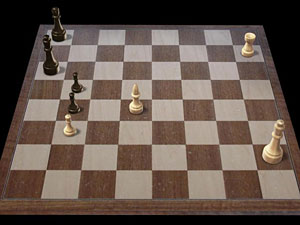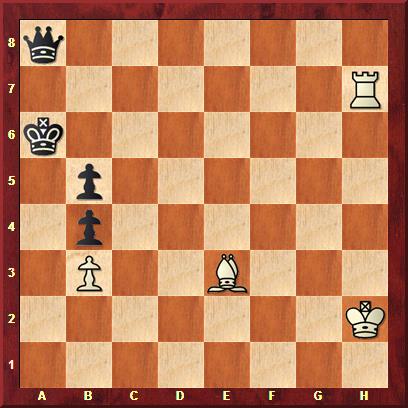


How much can you learn from a chess study or problem? Not to improve your solving skills, but for your over-the-board tournament play? Many chess players are suspicious, believing that outlandish positions and tricky solutions are of little use to their general skills. But many studies are quite useful and solving them will show you ideas and manoeuvres that will be genuinely useful in your practical play.
This, incidentally, is also true of endgame databases: trying to win a won position against the perfect defence of a computer, or watching it win such a position itself, will involve seeing a lot of preposterous moves. Watch, for instance, the computer force the defending king away from the back rank to win a queen vs rook endgame. But quite often you will encounter moves the like of which you have never seen before. And during a tournament game you may hit upon a situation that requires exactly that kind of move.
But back to studies. Here is a prize-winner we spotted in the July edition of the British magazine CHESS, which we ask you to explore for yourself. Note that the composer is not our dear friend Pal Benko – there is a one-letter difference to the author, who also hails from Hungary.
Pal Benno, 1st Prize , Magyar Sakkvilag 2006

White to play and win
A brief look at the position brings a few key factors to light: Black, who has an overwhelming force, is restricted to moving his queen back and forth between a8 and b8, since any other move will lead to immediate Ra7 mate. But how can White profit from this, and make any progress, enough to actually win?
One idea might occur to you: if the black queen is was on b7, White could check on the sixth rank, forcing the black king to a5, and then attack with the rook from a1 or a2. But of course the white king needs to be out of the way and safe from refuting checks by the black queen. But how to do this? The correct path is convoluted and subtle, but the only way to win.
Well, here's the deal: you, dear readers, are invited to try to solve the above problem by yourselves, ideally first with just a chess board and pieces, then together with a chess engine of your choice. You will find a surprisingly complex manoeuvre is required to execute the above plan, and finding all the subtlties will do absolutely no harm to your general playing strength in over the board chess.
In the original page we had made use of a new JavaScript PGN player that allowed you to solve the Benno study, with machine support, directly in your browser. We had given you just the starting positions and told you how you could move pieces around on the player, just like you do with ChessBase or Fritz. You could also click the "maximize" button on the right below the board to make the player fill your browser window (click it again or press ESC to return to normal size).

All this works in any game we publish. You can click on the little fan symbol in the middle, which will start an engine in your browser, and you can use that to analyse the position while entering moves. Click again to stop the engine.
![]()
Below the notation you have additional functions: "PGN" give you the current version of the game or games to store on your local computer, the cloud symbol will store it in your cloud database (assuming you have a ChessBase Account. There are also additional functions to promote, delete or cut lines, and and the edit functions Undo and Redo. All of these are available when you analyze games on the newspage in your browser.
Hopefully you were able to work out the subtle manoeuvres required to solve the Benno study. Here is a full didactic explanation, provided by our premium chess teacher IM Sagar Shah. Note that you can check any lines or ideas on the JavaScript board. "But why not ..." becomes a question you can answer by simply entering the move and watching how the engine reacts.

[Event "1.p Magyar Sakkvilág"] [Site "?"] [Date "2006.??.??"] [Round "?"] [White "Benno, Pal"] [Black "White to play and win"] [Result "1-0"] [Annotator "Friedel,Frederic/Shah,Sagar"] [SetUp "1"] [FEN "q7/7R/k7/1p6/1p6/1P2B3/7K/8 w - - 0 1"] [PlyCount "43"] [EventDate "2006.??.??"] {The thing which really confuses me in such positions is how to calculate. You clearly need to think long term in such situation, figure out the different setups and which ones will get Black into a zugwang. But while doing that it is easy to enter into a dream world and blunder into a simple tactic. Hence, while the first priority is long term strategic thinking, it is extremely important to be tactically vigilant. This is what the absolute elite excel in. } 1. Bd4 {Just improving the position of the bishop, controlling the g7 square. One thing is clear: White cannot ever sacrifice his rook and bishop for the queen. The pawn endgame would be drawn even if the white king is too close to the black pawns. Hence, White has to make Black give up his queen for the rook or to checkmate the black king.} Qb8+ 2. Kh1 $1 {You can find this move through the process of elimination.} (2. Kg2 $4 {loses quickly to} Qg8+ 3. Rg7 Qd5+ 4. Kf1 Qxd4 $19) (2. Kh3 Qc8+ 3. Kg3 (3. Kh2 Qc2+ $19) 3... Qg8+ 4. Rg7 Qb8+ 5. Kg2 Qa8+ {and the rain of checks will not end.}) 2... Qa8+ 3. Kg1 { The only way to start making progress. White aims to get his king on the queenside. It will be a long treacherous route, but that is the only way to play for a win.} Qg8+ (3... Qb8 {is possible but really doesn't make such a huge difference.}) 4. Rg7 Qb8 5. Kg2 (5. Kf2 {Once again moving too quickly will ruin everything} Qf4+ $1 $19) 5... Qa8+ 6. Kf2 Qb8 (6... Qf8+ 7. Ke3 Qe8+ 8. Kd2 {And the queen will have to return back to the the defence of the a7 square.}) 7. Ke3 Qe8+ (7... Qa8 8. Kd2 $1 $18 {The main line will explain you why this is winning.}) 8. Kd3 Qb8 (8... Qa8 {This move loses in the same fashion as the main line.} 9. Rf7 $1 $18) 9. Rg6+ $1 (9. Kc2 Qh2+ $11 {We don't really want to the queen to get activated by entering our territory. This will end in a draw.}) 9... Ka5 (9... Kb7 10. Rb6+ $18) 10. Rg1 $1 Ka6 { [%cal Rg1a1,Ga6b7] Now if the black queen was on b7 it would be Ra1 mate.} 11. Rg7 {The main idea of this manoeuvre was to force the black queen to a8.} Qa8 12. Rf7 $1 {[%csl Rf2][%cal Yf7f2,Gd4f2] This is an important subtlety. Why does the rook need to be on the f-file, as opposed to the g-file? Because the bishop can then block the check on the second rank, for instance after Qh2+ or Qg2+ by Bf2!} Qb8 13. Kc2 $1 Qa8 (13... Qh2+ 14. Bf2 $18 {is the neat point. The winning line is same as the main line.}) 14. Kb2 Qg2+ 15. Bf2 $1 {[%csl Rf2][%cal Yf7f2] Ahh, that's the reason: the bishop can block the check because it is protected by the rook on f7! The queen has to return to its thankless job of defending the a7 square.} Qa8 {Now that we have safely smuggled our king to the queenside all that remains to make the final preparations. The important thing is not to let the Black queen activate herself.} 16. Rh7 $1 {Taking the h2 and h8 square under control.} Qb8 17. Bd4 { The bishop takes the e5 square under control. What beautiful co-ordination.} Qa8 18. Ka1 $1 {[%cal Gh2h1,Gh1g1,Gg1g2,Gg2f2,Gf2e3,Ge3d3,Gd3c2,Gc2b2,Gb2a1] From h1 to a1! This journey of the king has made sure that White will win this game.} Qb8 19. Rh6+ $1 {The key part where you have to stop thinking strategically and put on your tactical thinking caps and find the win.} Ka5 { and now White can force the queen onto b7, where it blocks a vital escape square for the black king.} 20. Rh8 $1 {Attacking the queen which has only one square to go to as Ra8 is a mate.} Qb7 21. Rh2 $1 {There is no stopping the mate on a2! And the queen on b7 is the main reason why this entire thing works. } Ka6 22. Ra2# 1-0
Why is this problem so difficult to solve?
If you have both these qualities then you are surely on your way to becoming a very strong player. If you weren't able to solve this problem correctly, do not worry. It is only by trying that you can get better. Learn the patterns, store them in your mind. Keep doing this always and one day you will have enough in your arsenal to solve such positions correctly. After all there only 64 squares and 32 pieces on the chess board!